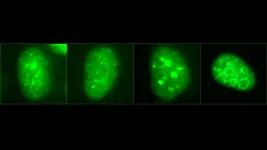How human cells coordinate the start of DNA replication
2021-03-23
(Press-News.org) Cold Spring Harbor Laboratory (CSHL) President and CEO Bruce Stillman has been dissecting DNA replication, a critical step in cell division, since the 1980s. His lab studies how Origin Recognition Complexes--ORCs--coordinate DNA duplication. They discovered how our cells assemble and disassemble ORCs during the cell division cycle. One ORC protein is sequestered into small liquid droplets, keeping it apart until the right time to recruit other proteins and initiate DNA replication.
The ORC recognizes where to initiate replication at numerous locations along the long, linear stretches of DNA in our cells' chromosomes. Fully assembled ORCs recruit other proteins to make precise copies of the chromosomes. This mechanism is necessary to inherit DNA accurately without errors that can lead to disorders such as cancer.
Scientists have studied the structure of ORCs in several species. Stillman explains:
"We've previously studied this in baker's yeast, but it turns out that human cells have a different way of doing things."
Unlike single-celled yeast, humans have a variety of cells that divide at different times. To choreograph this, the researchers found that one human ORC protein, ORC1, has certain regions that yeast ORC1 lacks. When ORC binds to DNA, ORC1 recruits CDC6, a protein that assembles other DNA replication proteins. Some of the human-specific regions of ORC1 and CDC6 bind other proteins that regulate DNA replication. Manzar Hossain, a research investigator in Stillman's lab, says:
"We found that ORC1 and CDC6 interact in a very tangential manner. We found a very short time period which allows them to interact."
DNA-bound ORC1 is sequestered into liquid droplets that briefly change shape, then brings in CDC6. Kuhulika Bhalla, a postdoc in Stillman's lab, explains:
"So if you can imagine a lava lamp, like you've got liquid, but you've got other colored liquid within it. And they still managed to stay separated."
Throughout most of the cell division cycle, ORC1 and CDC6 amounts oscillate in the cell. Stillman explains that "both high and low amounts of ORC1 lead to severe consequences for cell viability. So, you have to have just the right amount" of each protein throughout the cell cycle. Stillman and his colleagues have shown that CDC6 recruits other regulatory proteins that control the activity and levels of ORC1 in both space and time. They published their findings in Molecular Cell.
INFORMATION:
[Attachments] See images for this press release:

ELSE PRESS RELEASES FROM THIS DATE:
2021-03-23
Philadelphia, March 23, 2021 - During the COVID-19 pandemic, Joseph S. Alpert, MD, Editor-in-Chief of The American Journal of Medicine, published by Elsevier, has observed that although non-COVID inpatients suffered from the usual mix of conditions such as heart failure and chronic obstructive pulmonary disease exacerbations, the Internal Medicine inpatient population was distinctly different from what he had seen over the past decades. They were considerably sicker and closer to dying than in the past.
Dr. Alpert has been working on the Internal Medicine, Cardiac Care Unit, and Cardiology consult services. "At ...
2021-03-23
Have you ever wondered why you are able to hear a sentence and understand its meaning - given that the same words in a different order would have an entirely different meaning? New research involving neuroimaging and A.I., describes the complex network within the brain that comprehends the meaning of a spoken sentence.
"It has been unclear whether the integration of this meaning is represented in a particular site in the brain, such as the anterior temporal lobes, or reflects a more network level operation that engages multiple brain regions," ...
2021-03-23
Domestication has a consistent effect on the gut microbiota of animals and is similar to the effects of industrialisation in human populations, with ecological differences such as diet having a strong influence.
These findings, published today in eLife, highlight how the flexibility of the gut microbiota can help animals respond to ecological change and could help identify ways of manipulating gut microbial communities in the service of health.
Animals typically have complex communities of microbes living in their gut that can strongly influence functions such as immunity and metabolism. These communities ...
2021-03-23
A new study co-authored by a Tulane University geoscientist shows that human efforts to tame the Mississippi River may have had an unintended positive effect: more rapid transport of carbon to the ocean.
The paper, published in AGU Advances, describes the work of a team of researchers who set out to learn more about the fate of organic carbon that is transported in large quantities by the Mississippi River. Organic carbon is mainly derived from plant remains, soils, and rocks, throughout the drainage basin of the Mississippi River that covers about 40% of the United States.
"We estimate that over the past century, the amount of organic carbon lost to the atmosphere during Mississippi River transport to the Gulf of Mexico ...
2021-03-23
"Several countries, including the United Kingdom and Canada have stated that they will delay second doses of COVID-19 vaccines in response to supply shortages, but also in an attempt to rapidly increase the number of people immunized," explains Chadi Saad-Roy, a graduate student in the Departments of Ecology and Evolutionary Biology (EEB) and Quantitative and Computational Biology in the Lewis-Sigler Institute at Princeton and the lead author of the study.
"The original clinical trials of the vaccines, plus subsequent epidemiology, are quite optimistic regarding the efficacy of the first dose. However, ...
2021-03-23
Featured on the cover of the Soil Science Society of America Journal, researchers at the University of Maryland (UMD) and the Spanish National Research Council partnered to create a new camera allowing for the imaging of wetland soil activity in real time. This camera gives the classic IRIS (indicator of reduction in soils) technology a big upgrade. IRIS is used universally by researchers and soil assessors to determine if soils are behaving like wetland soils and should therefore be classified as such. However, before this new camera, soil assessors couldn't quantify the rate of iron reduction in saturated wetland soils, and ...
2021-03-23
BOSTON - An analysis of sex differences in the genetics of schizophrenia, bipolar disorder and major depressive disorders indicates that while there is substantial genetic overlap between males and females, there are noticeable sex-dependent differences in how genes related to the central nervous system, immune system, and blood vessels affect people with these disorders.
The findings, from a multinational consortium of psychiatric researchers including investigators and a senior author at Massachusetts General Hospital (MGH), could spur better treatments for major psychiatric disorders. They are published in the journal Biological Psychiatry.
The findings were made possible only through the cooperation of more than 100 investigators and research groups, ...
2021-03-23
A new technique that can trace which tissues and organs the DNA in our blood comes from has been reported today in the open-access eLife journal.
The method, called GETMap, could be used in prenatal screening, to monitor organ transplant rejection, or test for cancers that are concealed in the body.
"Analysis of circulating free DNA has been shown to be useful for screening for early asymptomatic cancers," explains first author Wanxia Gai, Postdoctoral Fellow at the Chinese University of Hong Kong, Hong Kong SAR, China. "As cancer-associated DNA changes are present in ...
2021-03-23
In a letter to The New England Journal of Medicine, published online March 23, 2021, a group of investigators from University of California San Diego School of Medicine and the David Geffen School of Medicine at UCLA report COVID-19 infection rates for a cohort of health care workers previously vaccinated for the novel coronavirus.
"Because of the compulsory daily symptom screening of health care personnel, patients, and visitors, and the high testing capacity at both UC San Diego Health and UCLA Health, we were able to identify symptomatic and asymptomatic infections among health care workers at our institutions," said co-author ...
2021-03-23
Boulder, Colo., USA: When geobiology graduate student Katie Maloney trekked into the mountains of Canada's remote Yukon territory, she was hoping to find microscopic fossils of early life. Even with detailed field plans, the odds of finding just the right rocks were low. Far from leaving empty-handed, though, she hiked back out with some of the most significant fossils for the time period.
Eukaryotic life (cells with a DNA-containing nucleus) evolved over two billion years ago, with photosynthetic algae dominating the playing field for hundreds of millions of years as oxygen accumulated in the Earth's atmosphere. Geobiologists think that algae evolved first in freshwater environments ...
LAST 30 PRESS RELEASES:
[Press-News.org] How human cells coordinate the start of DNA replication


